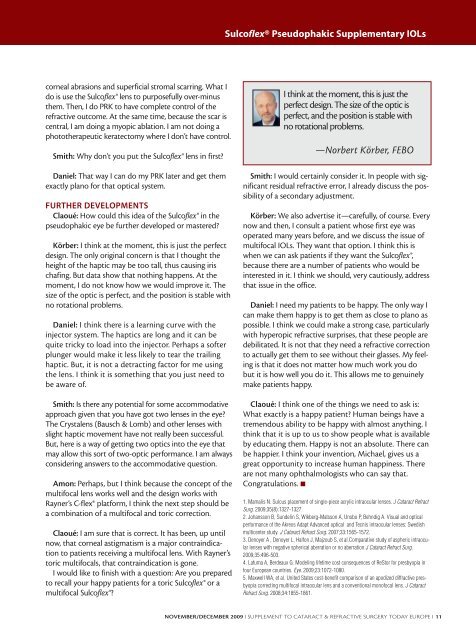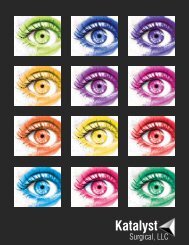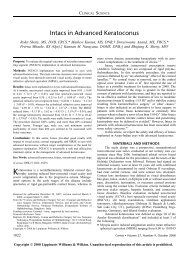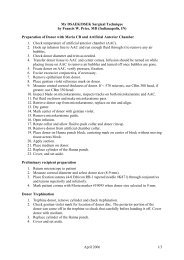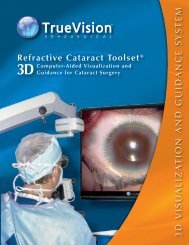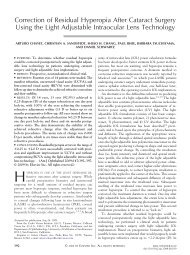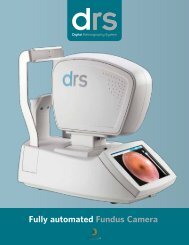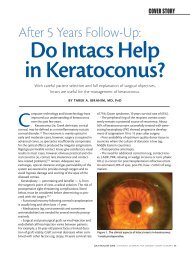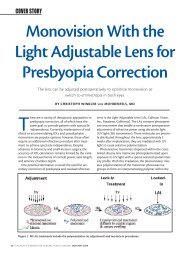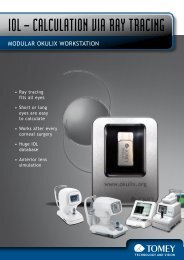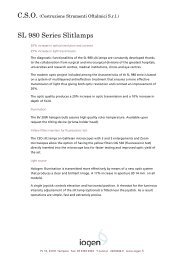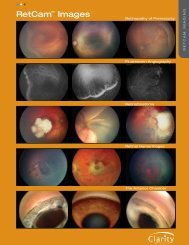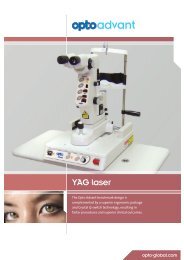Sulcoflex ®Pseudophakic Supplementary IOLs - Iogen
Sulcoflex ®Pseudophakic Supplementary IOLs - Iogen
Sulcoflex ®Pseudophakic Supplementary IOLs - Iogen
You also want an ePaper? Increase the reach of your titles
YUMPU automatically turns print PDFs into web optimized ePapers that Google loves.
corneal abrasions and superficial stromal scarring. What I<br />
do is use the <strong>Sulcoflex</strong>® lens to purposefully over-minus<br />
them. Then, I do PRK to have complete control of the<br />
refractive outcome. At the same time, because the scar is<br />
central, I am doing a myopic ablation. I am not doing a<br />
phototherapeutic keratectomy where I don’t have control.<br />
Smith: Why don’t you put the <strong>Sulcoflex</strong>® lens in first?<br />
Daniel: That way I can do my PRK later and get them<br />
exactly plano for that optical system.<br />
FURTHER DEVELOPMENTS<br />
Claoué: How could this idea of the <strong>Sulcoflex</strong>® in the<br />
pseudophakic eye be further developed or mastered?<br />
Körber: I think at the moment, this is just the perfect<br />
design. The only original concern is that I thought the<br />
height of the haptic may be too tall, thus causing iris<br />
chafing. But data show that nothing happens. At the<br />
moment, I do not know how we would improve it. The<br />
size of the optic is perfect, and the position is stable with<br />
no rotational problems.<br />
Daniel: I think there is a learning curve with the<br />
injector system. The haptics are long and it can be<br />
quite tricky to load into the injector. Perhaps a softer<br />
plunger would make it less likely to tear the trailing<br />
haptic. But, it is not a detracting factor for me using<br />
the lens. I think it is something that you just need to<br />
be aware of.<br />
Smith: Is there any potential for some accommodative<br />
approach given that you have got two lenses in the eye?<br />
The Crystalens (Bausch & Lomb) and other lenses with<br />
slight haptic movement have not really been successful.<br />
But, here is a way of getting two optics into the eye that<br />
may allow this sort of two-optic performance. I am always<br />
considering answers to the accommodative question.<br />
Amon: Perhaps, but I think because the concept of the<br />
multifocal lens works well and the design works with<br />
Rayner’s C-flex® platform, I think the next step should be<br />
a combination of a multifocal and toric correction.<br />
Claoué: I am sure that is correct. It has been, up until<br />
now, that corneal astigmatism is a major contraindication<br />
to patients receiving a multifocal lens. With Rayner’s<br />
toric multifocals, that contraindication is gone.<br />
I would like to finish with a question: Are you prepared<br />
to recall your happy patients for a toric <strong>Sulcoflex</strong>® or a<br />
multifocal <strong>Sulcoflex</strong>®?<br />
<strong>Sulcoflex</strong>® Pseudophakic <strong>Supplementary</strong> <strong>IOLs</strong><br />
I think at the moment, this is just the<br />
perfect design. The size of the optic is<br />
perfect, and the position is stable with<br />
no rotational problems.<br />
—Norbert Körber, FEBO<br />
Smith: I would certainly consider it. In people with significant<br />
residual refractive error, I already discuss the possibility<br />
of a secondary adjustment.<br />
Körber: We also advertise it—carefully, of course. Every<br />
now and then, I consult a patient whose first eye was<br />
operated many years before, and we discuss the issue of<br />
multifocal <strong>IOLs</strong>. They want that option. I think this is<br />
when we can ask patients if they want the <strong>Sulcoflex</strong>®,<br />
because there are a number of patients who would be<br />
interested in it. I think we should, very cautiously, address<br />
that issue in the office.<br />
Daniel: I need my patients to be happy. The only way I<br />
can make them happy is to get them as close to plano as<br />
possible. I think we could make a strong case, particularly<br />
with hyperopic refractive surprises, that these people are<br />
debilitated. It is not that they need a refractive correction<br />
to actually get them to see without their glasses. My feeling<br />
is that it does not matter how much work you do<br />
but it is how well you do it. This allows me to genuinely<br />
make patients happy.<br />
Claoué: I think one of the things we need to ask is:<br />
What exactly is a happy patient? Human beings have a<br />
tremendous ability to be happy with almost anything. I<br />
think that it is up to us to show people what is available<br />
by educating them. Happy is not an absolute. There can<br />
be happier. I think your invention, Michael, gives us a<br />
great opportunity to increase human happiness. There<br />
are not many ophthalmologists who can say that.<br />
Congratulations. ■<br />
1. Mamalis N. Sulcus placement of single-piece acrylic intraocular lenses. J Cataract Refract<br />
Surg. 2009;35(8):1327-1327.<br />
2. Johansson B, Sundelin S, Wikberg-Matsson A, Unsbo P, Behndig A. Visual and optical<br />
performance of the Akreos Adapt Advanced optical and Tecnis intraocular lenses: Swedish<br />
multicenter study. J Cataract Refract Surg. 2007;33:1565-1572.<br />
3. Denoyer A , Denoyer L, Halfon J, Majzoub S, et al.Comparative study of aspheric intraocular<br />
lenses with negative spherical aberration or no aberration.J Cataract Refract Surg.<br />
2009;35:496-503.<br />
4. Lafuma A, Berdeaux G. Modeling lifetime cost consequences of ReStor for presbyopia in<br />
four European countries. Eye. 2009;23:1072-1080.<br />
5. Maxwell WA, et al. United States cost-benefit comparison of an apodized diffractive presbyopia<br />
correcting multifocal intraocular lens and a conventional monofocal lens. J Cataract<br />
Refract Surg. 2008;34:1855-1861.<br />
NOVEMBER/DECEMBER 2009 I SUPPLEMENT TO CATARACT & REFRACTIVE SURGERY TODAY EUROPE I 11


